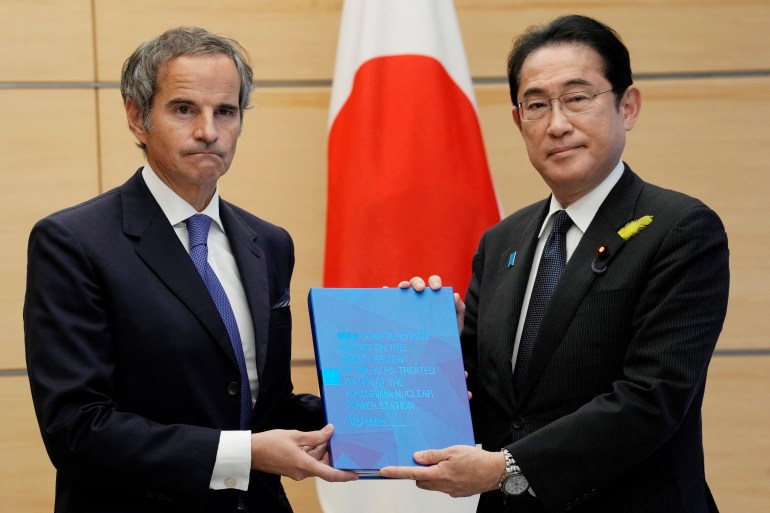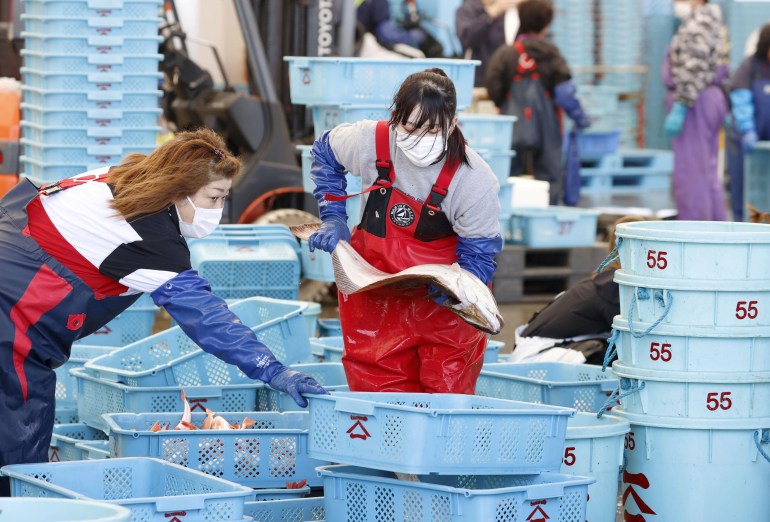Here is a timeline of key events related to the Fukushima disaster and Japan’s efforts to clean up the site and close down the plant.
2011
March 11
A magnitude 9 earthquake off the coast of northeastern Japan triggers a devastating tsunami that knocks out power and cooling systems at Tokyo Electric Power Co’s (TEPCO) Fukushima Daiichi plant, leading to the meltdown of three of its six reactors.
The government declares a nuclear emergency.
March 12
A hydrogen explosion occurs at the plant’s reactor number one, releasing radiation into the air, and residents within a 20km (12-mile) radius are ordered to evacuate. Similar explosions occur at the two other damaged reactors over the following days.
TEPCO, meanwhile, begins using seawater to cool the reactors’ fuel rods.
April 4
After running out of storage capacity for the water used to cool the overheated fuel rods, engineers release more than 10,000 tonnes of the heavily contaminated water – about 100 times more radioactive than legal limits – into the Pacific, affecting fish and angering local fishing groups.
April 12
Japan raises the accident to category 7, the highest level on the International Nuclear and Radiological Event Scale, from category 5, based on radiation released into the atmosphere.
December 16
Japan announces Fukushima’s damaged reactors are in a stable state of “cold shutdown”.
2012
July 23
A government-appointed independent investigation concludes that the nuclear accident was caused by a lack of adequate safety and crisis management by TEPCO, lax oversight by nuclear regulators and collusion.
2013
March 30
An Advanced Liquid Processing System (ALPS) begins operating to improve the treatment of contaminated water.
July 22
TEPCO says radioactive water continued to leak from the plant into groundwater, making it radioactive, with implications for drinking water and the Pacific Ocean.
2014
April 1
Residents begin to return to the exclusion zone around Fukushima as decontamination of the area is completed.
December 22
The company completes the removal of spent nuclear fuel rods from the cooling pool of reactor number four, an initial milestone in a decommissioning process that is expected to take years.
2016
March 31
TEPCO introduces an underground wall that is cooled to freezing temperatures around four reactor buildings as a way of reducing the amount of groundwater seeping into reactor basements and mixing with the highly radioactive cooling water leaking from the melted reactors.
2018
October 1
TEPCO says water treated at the Fukushima site still contains radioactive materials and apologises to the government after previously insisting the materials had been removed. About 1 million tonnes of water are now stored at the plant, enough to fill about 500 Olympic swimming pools.

November 13
The International Atomic Energy Agency (IAEA), the United Nations’ nuclear watchdog, says Japan must urgently tackle the build-up of contaminated water.
April 13
Japan says it has decided to release the water into the sea, drawing anger from China, which calls the move “extremely irresponsible”, as well as South Korea, which summons the Japanese ambassador. Local fishermen also make clear their opposition to the plan.
2020
February 10
A government panel recommends the contaminated water’s controlled release into the sea. TEPCO says the site will reach the limit of its storage capacity of 1.37 million tonnes in the first half of 2024.
2021
December 28
Japan maps out a plan for the water release that includes compensation standards for local industry and the compilation of a safety report.

2023
July 4
Japan secures approval for the water release from the IAEA following a two-year review and a visit to the site by its chief Rafael Grossi. IAEA says the Japanese plans are consistent with global safety standards and would have “negligible radiological impact” on people and the environment.
July 7
Citing its own assessment and review of evidence, South Korea says it believes the water release will be safe if carried out as detailed in the proposal.
August 22
Japanese Prime Minister Fumio Kishida, after visiting the plant to highlight the safety of the water release plan and pledging long-term support for fisheries groups, announces the discharge will begin in 48 hours if weather and sea conditions allow. The announcement leads to strong condemnation from China and concern among the fisheries industry.
August 24
TEPCO announces the release of the water has begun. At protests in Seoul, at least 14 people are detained after they try to break into the Japanese embassy.
Condemning Japan’s decision to go ahead with the discharge, China announces the suspension of all imports of aquatic products from Japan.

